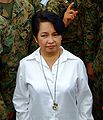Vice President of the Philippines
| the Philippines | |
| Vice President of the Philippines |
 |
|---|
|
|
The Vice President of the Philippines is the second highest executive official of the Philippine government. The Vice President of the Philippines in Filipino is Ang Pangalawang Pangulo or Pangalawang Pangulo (or "Bise Presidente" informally), for example Ang Pangalawang Pangulong Noli L. De Castro. The Vice President is the first in the presidential line of succession. The Vice President also becomes the new President upon the death, resignation, or removal by impeachment and subsequent conviction of the President. The position was temporarily abolished by martial law in 1972, and was restored by amendments to the 1973 Constitution in time for the national "snap" elections of 1986. The subsequent, and present, 1987 Constitution retained the position. The office of the Vice President is located in the Philippine International Convention Center in Pasay City, Metro Manila.
Description
Unlike the position of Vice-President in the United States, the Vice-President of the Philippines has no official responsibility other than those given by the incumbent President of the Philippines. The traditions governing the position of Vice-President date back to the Philippine Commonwealth, and the first Vice-President, Sergio Osmena (while there was a similarly-named position in governments prior to the First Philippine Republic, the position did not exist under what is considered the first official national government set up in 1898). The tradition is for the Vice-President to be given the highest-ranking cabinet portfolio.
History
Before independence
The first known vice president claiming to be part of a government was Mariano Trias. He was elected during the elections of the Tejeros Convention, and was later elected vice president of the Supreme Council that oversaw negotiations for the Biak na Bato pact in 1897. This Supreme Council had no sovereignty, did not govern any state, and was just used for bargaining with the Spanish. This council was replaced later, with no such position existing during the country's declaration of independence in 1898, which had a dictatorial government. Officially, the country's first actual republic was founded in 1899, and it too had no vice president. Trias instead served in the cabinets of Apolinario Mabini and Pedro Paterno, as finance minister and war minister, respectively.
Vice Presidents

The 1935 Constitution of the Philippines established the position of Vice-President, with no required responsibilities, although the President could, if he so chose, appoint the Vice-President to a cabinet position. The first person elected to the position of Vice-President under the constitution was Sergio Osmena. Elected together with Manuel L. Quezon in the first Philippine national elections, Osmena was given the highest-ranking cabinet portfolio with inauguration of the Commonwealth of the Philippines in November, 1935. Prior to independence in 1946, that cabinet portfolio was Secretary of Public Instruction, which had once been reserved only for the Vice Governor-General (an American). Vice-President Osmena held that position from 1935-1939, and a similar portfolio in the War Cabinet during World War II. After independence, the highest-ranking cabinet position became that of Secretary of Foreign Affairs (it is still the highest-ranking cabinet portfolio in official protocol to this day), which was given to Vice-President Elpidio Quirino. Vice-President Fernando Lopez declined the Foreign Affairs portfolio when he became Quirino's Vice-President in 1949.
However, Vice-Presidents Carlos P. Garcia and Emmanuel Pelaez also held the Foreign Affairs portfolio, a tradition revived in the Fifth Republic, with Vice-Presidents Salvador Laurel and Teofisto Guingona, Jr. holding the Foreign Affairs portfolio. Alone of the Vice-Presidents of the Third Republic, Diosdado Macapagal was not given any cabinet position, since he was the first Vice-President elected who did not come from the same party as the incumbent.

Succession
Succession in case of the incapacitation or death of the President of the Philippines has occurred thrice:
- Sergio Osmena's assumption to the presidency upon the death of Manuel Quezon due to tubercolosis in 1944.
- Elpidio Quirino's succession in 1948 upon the death of Manuel Roxas due to Heart Attack.
- Carlos P. Garcia's assumption of the presidency in 1957 after the crash of the Philippine Presidential Plane where Ramon Magsaysay was boarded.
A Vice-President has become President by virtue of resignation (or abandonment of office, depending on the argument used):
- Gloria Macapagal-Arroyo upon resignation of Joseph Estrada in 2001.
Gallery
-
Noli de Castro, 14th Vice President.
-
Teofisto Guingona, Jr., the 13th Vice President.
-
President Gloria Macapagal-Arroyo, the 12th Vice President
-
President Joseph Estrada, the 11th Vice President
-
Salvador Laurel, the 10th Vice President.
-
Arturo Tolentino, the 9th Vice President.
-
Fernando Lopez, the 4th and 8th Vice President.
-
Emmanuel Pelaez, the 7th Vice President.
-
President Diosdado Macapagal, the 6th Vice President
-
President Carlos P. Garcia, the 5th Vice President
-
President Elpidio Quirino, the 3rd Vice President
-
President Sergio Osmeña, the 2nd Vice President
-
Mariano Trias, the 1st Vice President.
Honourable Title
The proper term of address for the Vice-President is
- "The Honorable First Name Family Name, Vice-President of the Philippines."
- "Mr. Vice-President" or "Madam Vice-President"




